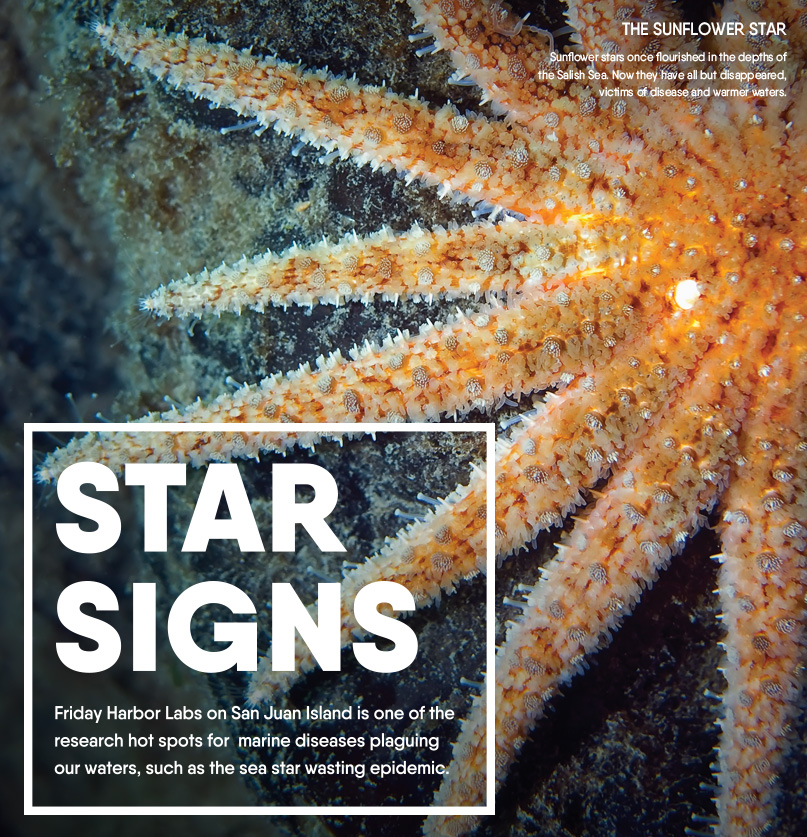
 The bow of the ferry to San Juan Island slips through the clear, green-blue water that reflects the evergreen-lined mountains and the clear, bright sky. No wonder the Salish Sea is considered a boater’s paradise. When we go out on the water, most of us feel peaceful and have a sense that all is well with the world.
The bow of the ferry to San Juan Island slips through the clear, green-blue water that reflects the evergreen-lined mountains and the clear, bright sky. No wonder the Salish Sea is considered a boater’s paradise. When we go out on the water, most of us feel peaceful and have a sense that all is well with the world.
Looks can be deceiving. Yes, on the surface the marine environment we boaters enjoy and explore seems serene and unaltered, but there are detrimental changes occurring below. One of the major threats is something that we can’t even see—pathogens. Pathogens are microorganisms such as bacteria, viruses, and fungi that can cause disease in marine life, given the right conditions. Now, thanks to climate change, the right conditions are occurring.
These invisible agents of destruction have floated in salt water for eons, but the recent warming of the oceans is activating them, transforming them into micro-monsters, and creating plagues on compromised sea life.
Luckily for the Salish Sea, the unique beauty and diversity of the region not only attracts boaters but scientists as well. They are on the front lines in the battle to determine how our rapidly changing world is affecting the Salish Sea and global ocean. We can only find the solutions to our problems if the problems are clearly understood. Know your enemy.
Some of the most vital investigative work on the marine infectious diseases is being led by Dr. Drew Harvell at Friday Harbor Laboratories on San Juan Island. She has been diving deep into the relationship between warmer waters and the obliteration of marine invertebrate species, like coral and sea stars, since she was a graduate student at the University of Washington.
Like a marine Sherlock Holmes, Dr. Harvell tracks down killers, in her case the microscopic ones decimating coral reefs, sea stars, and sea grass. With the oceans heating up, she’s been busy. The warmest three-year period in coastal waters along the West Coast occurred in 2014 to 2016. The hottest year ever recorded for the global ocean was 2018. According to the journal Advances in Atmospheric Sciences, the oceans are warmer now than at any point since temperatures have been recorded.
“A warmer world is a sicker world,” Dr. Harvell simply states.
We know the health of our Salish Sea and oceans are in peril. Struggling orca pods and declining runs of salmon grab the headlines. There are far fewer sea stars hugging the dock pilings after a decimating wasting disease wiped out more than half the population.
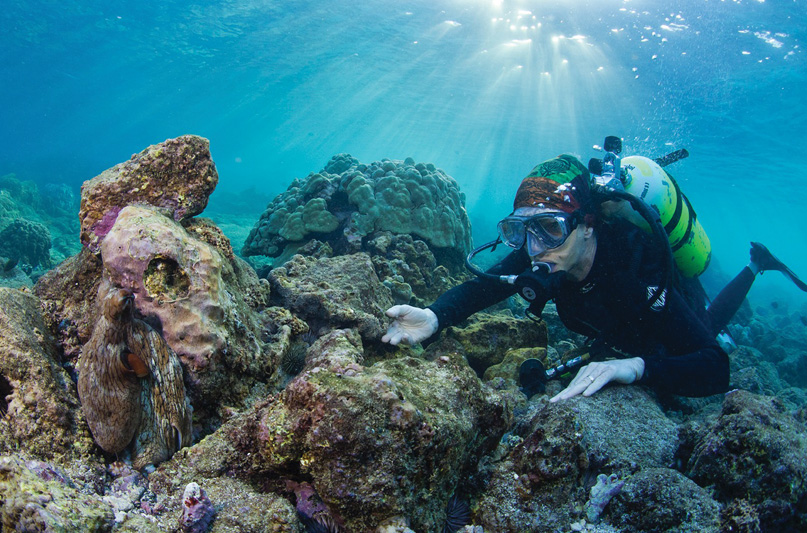
An experienced diver, she’s explored the world’s oceans.
The Abalone Withering Syndrome, caused by a slowly incubating rickettsial bacteria that atrophies the foot muscle inside the rainbow shells, decimated white and black abalone in California. The rickettsia is in the same family as the lyme disease pathogen. There are concerns about the withering syndrome striking the pinto abalone, which is abundant in our waters. Eelgrass, which filters the water on our shores, is being hit with slime mold that weakens its internal structure, stops photosynthesis, and eventually kills off the seagrass beds.
All these diseases, although they are different pathogens attacking individual species, can increase in warming waters. The disease can be slow, as in the abalones, or hit fast, like the dramatic near-disappearance of the sea star—the very symbol of salt water.
The sea star wasting disease took the scientific world by surprise in 2013. It was fast, widespread, and lethal. A consensus of scientists say it was the largest marine epidemic on record. At least 24 different species of echinoderms from Mexico to Alaska, including the once abundant purple-orange ochre star fish and the magnificent sunflower star that can be several feet in diameter, were affected by the wasting disease.
Today, you can find the ochre star (Pisaster ochraceus) if you look in the nooks and crannies of the intertidal zone, but the population has dwindled and the loss affects the whole marine ecosystem. Have you noticed an abundance of barnacles lately on the rocks and perhaps your boat?
Without the sunflower stars to keep order in the kelp beds, the urchin population exploded. The hungry urchins have been eating kelp beds up and down the West Coast, and the kelp beds are like nurseries for fish and other marine life. The disease continues today, but there are some bright spots. The ochre star seems to be building resistance to the disease, but others, like the sunflower star (Pycnopodia helianthoides) that once carpeted the sea floor, are hard to find in the Salish Sea.
Dr. Harvell was front and center in the fight to determine what was turning sea stars into marine zombies. The stars would keep on moving after losing limbs and continue crawling until they turned into a puddle of goo. The Research Coordination Network for Ocean Health, headed by Harvell and funded by the National Science Foundation, went on high alert upon detection of the epidemic.
The scientists are like a team of detectives and searched diligently for the cause of the sea star demise. Science did not move as fast as the disease, but they still published a paper in late 2014 with evidence for a virus as the cause. In a paper published in the January 2019 Science Advances, Harvell and other scientists state the decline in sea stars was directly related to warm sea surface temperatures. The journal article created headlines around the world.
As a graduate student of marine ecology at the University of Washington, she had no idea her career would lead her to the front lines of the climate crisis. The first signs that something was up with the world’s oceans started early on in her career, as she describes in her book, Ocean Outbreak, published this year.
When Dr. Harvell was on a group dive in Panama as a University of Washington doctoral student in 1982, the group was among the first to detect coral bleaching. Maybe you have seen those photos that show coral with no color or life? That’s bleaching, which occurs when coral becomes stressed, and then evicts the tiny organisms that give coral its color and life.
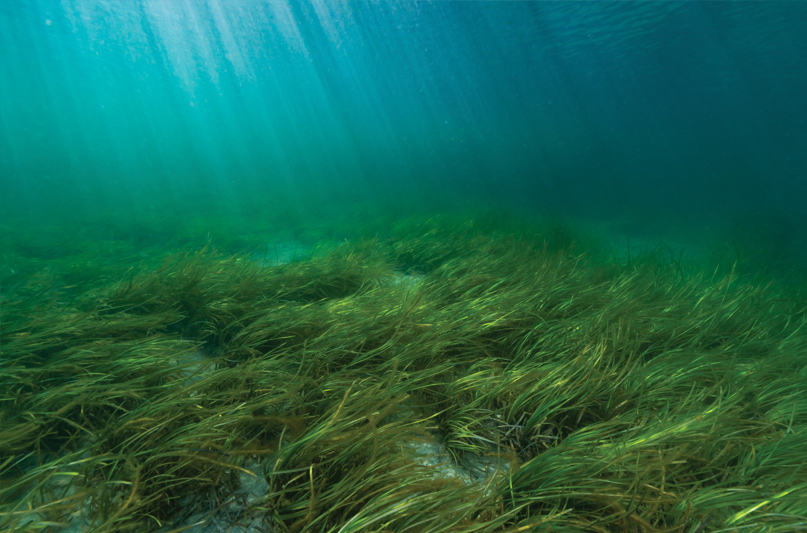
She went on to study what exactly was causing ill health of coral—pollution, plastic garbage, and warmer water. But it was the sea stars’ fall that hit home and broke her heart.
An accomplished diver, she worked on the low tide around Alki Point in West Seattle when she first heard reports of the sea stars’ nightmarish demise. Dr. Harvell had to see the disaster herself. When she saw three different species of sea stars littering the beach, her first thought was “this was bad, real bad.”
After the outbreak, she and three other scientists testified in front of Congress in support of the Emergency Marine Disease Act, introduced in 2015 by Rep. Denny Heck (D-WA). The lack of knowledge about the ocean’s woes among some Congress members set off alarm bells for Harvell. When the marine bill failed, Dr. Harvell resolved to educate not only future scientists in her classes but the public as well.
She wrote two books: A Sea of Glass in 2016 and Ocean Outbreak, which was released in June of this year. Ocean Outbreak describes not only outbreaks of abalone, salmon, seastars and coral diseases, but Harvell’s personal story as a scientist to study these outbreaks around the world. She is currently working on a documentary about the outbreak of diseases and speaking to various groups around Puget Sound, including yacht clubs such as the Seattle Yacht Club.
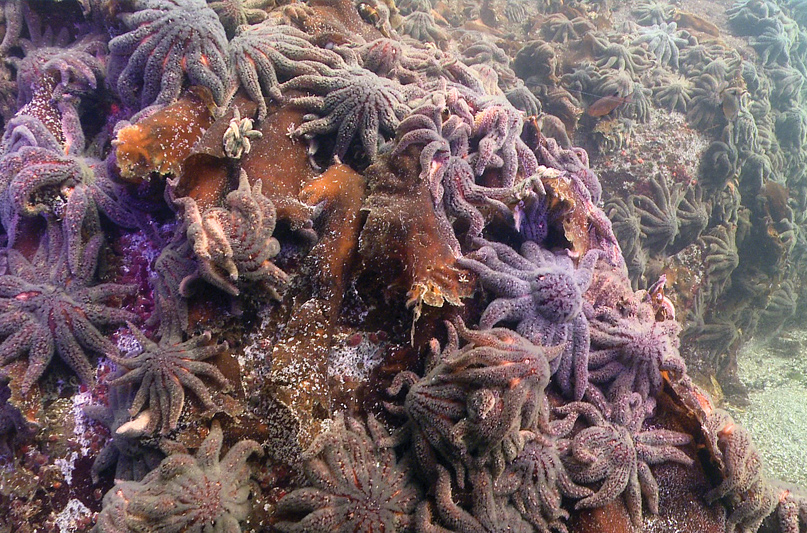
Her work has taken her to all continents except Antarctica, but Dr. Harvell has her fins deep in the waters of Puget Sound. Her love of the Salish Sea stayed with Dr. Harvell even after she went on to be a professor at Cornell University in Ithaca, New York. It was at Friday Harbor Labs where she met her calling and her husband, oceanographer Charles Greene. Both teach at Cornell University, but call San Juan Island their home eight months out of the year. Cornell has worked out a partnership with the University of Washington, which runs Friday Harbor Laboratories, that allows both institutions to use the Labs.
The beauty and the biodiversity of Pacific Northwest waters first attracted Dr. Harvell and keeps her here. “I fell in love with the spineless creatures of the Salish Sea,” she said as she gently poked a sea cucumber in her Friday Harbor lab, the place where she did her graduate research.
“They are the engines of the ocean as well as masterpieces of nature.” She smiles with delight looking at the tanks filled with the invertebrates that float in our waters and cling to our shores. These include sea slugs, crabs, sponges, abalone, anemones, and of course, sea stars.
Outside her office is the best laboratory in the world, the Salish Sea. This summer, Dr. Harvell led a class of students from around the world in a course titled “The Ecology of Infectious Marine Disease.”
It was on a field study for a previous class that Dr. Harvell noticed the spread of the disease, now prevalent among eelgrass beds along the West Coast. What was causing the destructive disease? Did warmer waters spread the disease more rapidly? “It’s all about asking the right questions,” she said.
Once again, Dr. Harvell and her troops were on a quest to find the answers. She and her colleagues from other prominent research institutions received a three-year, $1.3 million grant from the National Science Foundation in 2018 to study eelgrass. The study will be conducted up and down the West Coast, from Southern California to Alaska. The group of lead scientists from the Smithsonian, Cornell, University of California, and University of Central Florida include marine biologists, ecologists, geographers, and computer scientists.
They will employ tools such as artificial intelligence and drones to track the elusive threats to eelgrass. At the Friday Harbor site, tubs of eelgrass surround the buildings and eelgrass beds float in the inlet below the compound.
Eelgrass is considered a foundational species of coastal waters because they provide habitat for salmon and other fish, prevent erosion, and filter pollutants. Eelgrass beds also eliminate pathogens and sequester carbon. Without eelgrass, our shores and seas would be so different. While disease has struck the East Coast eelgrass previously, the West Coast is now experiencing a new outbreak.
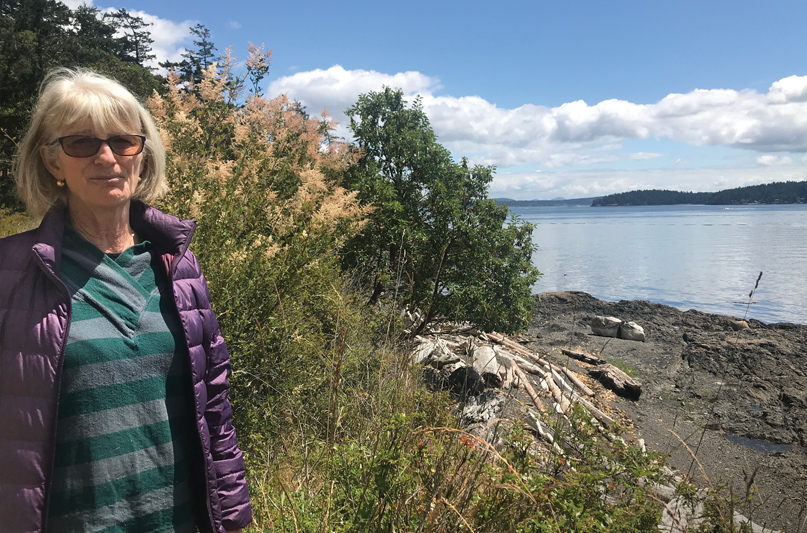
What’s new on the Pacific Ocean side is a microscopic slime mold called Labyrinthula zosterae (a protozoan) that infects the seagrass with a wasting disease. The disease wiped out most of the East Coast beds in the 1930s. The disease prevents photosynthesis and covers the eelgrass blade with brown and black spots.
It is extremely infectious. The researchers are trying to figure out why some eel beds, like those near Morro Bay in California, are devastated and other eelgrass beds are not.
This is similar the mystery of why some sea stars survived the wasting disease and others did not. Why did some stars not even fall victim to the wasting disease? What exact virus caused the demise? Research points to a possible suspect called a densovirus, related to the parvovirus of dogs. To this day, the scientists do not have the definitive cause of the disease. Despite remaining questions about the star-wasting disease, Dr. Harvell’s focus is now on the troubles with eelgrass.
It’s all about the funding. Without it, Dr. Harvell and fellow scientists are left high and dry. Funding for basic science is becoming harder and harder to obtain. For every five grants Dr. Harvell writes, she receives one, she says.
A lack of financial resources was one of the major reasons sea star studies stalled. To do lab experiments with sea stars was time-consuming and expensive because the stars do not have cells conducive for laboratory study.
“The star epidemic happened so quickly, we couldn’t wait for funding,” she says. The marine science community turned to the public for help and with local documentary filmmaker Laura James’ video on the stars’ decline, they got national media attention.
A sixth-grade class in Conway, Arkansas, was so worried about the sea stars that it held a “Save Our Stars” fundraiser that raised $400 for the cause. Dr. Harvell and her husband matched the donation, and then a private donor tripled the match. The funds generated by those young students supported the scientists’ field surveys.
Local scuba divers also provided support for the research. Since 2006, the scuba diving organization REEF had been keeping track of different sea life seen during dives. Over 11,000 citizen-scuba diver surveys were collected by REEF. This has proved to be an invaluable baseline for the scientists.

With the eelgrass study, Dr. Harvell is contemplating how boaters, who know this special marine paradise inside out, could use their knowledge, access, and resources to help the Salish Sea. One idea running through her head is asking boaters to sponsor students on their voyages through the Inside Passage.
“Boaters have access to places we can’t reach on our own, and the more data we collect, the better.” When it comes to citizen scientists, Dr. Harvell stresses that the REEF program was so successful because the divers were trained to collect data.
On citizen scientists participating in the eelgrass study, she opines, “They have to be organized and informed enough so the data collected can be useful.”
It’s reassuring to hear Dr. Harvell talk about the integrity of the science. This study is not opinion, but science. The research must hold up under scrutiny and be able to be replicated in the lab.
This work is being done by students and researchers taking Dr. Harvell’s classes and those in her lab: two PhD candidates, two undergraduates, and one post-doctoral scholar. She worries about how students can support themselves while doing this work.
For students at Friday Harbor Labs, it costs about $6,000 for tuition and housing for one term there. Donations are necessary for scholarships; these graduate students are the foot soldiers of research. “They are the ones taking the reins, she says. “We need them. These issues are not going away.”
Dr. Harvell shakes her head when asked if we could stop the warming of the oceans. “We could have solved this problem 20 years ago if we wanted to…” She looks out onto the peaceful scene from her lab — the sun shining, the water lapping at the rocky shore, and students coming in on an aluminum skiff. “It will take more time and be more expensive now,” she says, with a note of anger in her normally soothing voice.
There is work to be done, and no time to waste. Together with her colleagues, she is tackling the big questions of the moment. She writes in Ocean Outbreak, “After all, if we can’t identify and diagnose the problems, how can we even think about preventing or fixing them.”
Neither the problems or the solutions are easy, but Dr. Harvell does not want “to leave people without hope.” She is not only defining the problem with other scientists, but sounding the alarm to all who will listen and proposing solutions for how to manage healthier oceans.
The stunning water with its otherworldly marine life beneath our boats may be an alien world to us, but we are part of this same web of life. Our future is intertwined with this place of exquisite beauty.
Maybe this is what gives us that sense of serenity when we are out in the Salish Sea. Frontline warriors like Dr. Harvell could be our best chance at understanding and preserving the waters that nourish and sustain us.


